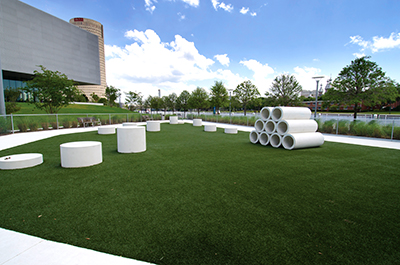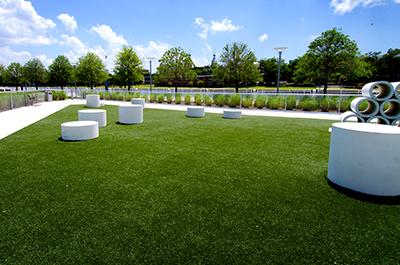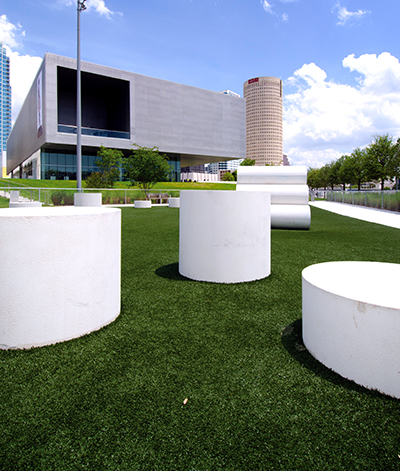
Artificial Grass:
How to Get It Right and Keep It Right
By Ken Karmie
Artificial grass in your pet facility is typically a significant investment. It can take an unsightly and semi-functional area and turn it into a beautiful, easy-to-maintain, play-and-potty palace for the dogs. When it is done right, it can pay for itself within the first year. Done right, it can be a key difference-maker for you and your business providing beauty and peace of mind for years. Notice the emphasis on “done right,” because taking short cuts in product, installation, or maintenance can leave you dissatisfied.
This article does not provide detailed specifics on all the desired product features and installation techniques. Previous articles in Pet Boarding & Daycare have covered much of that. This article highlights the most critical features as they pertain to the three key success components: product, installation, and maintenance. There is a basis of information you need to ensure success and alignment with your expectations. Unfortunately, many turf providers do not know about the unique needs of the boarding industry. Experience with golf greens, football fields, or playgrounds does not translate into expertise in pet facilities. A “pet-friendly name” does not make it a “pet-friendly product” or installation.
The success of this type of installation will be determined by the following:
- The effectiveness of keeping liquids moving quickly and efficiently through grass and base. You want urine to pass effectively and high volumes of water from cleaning processes and weather to pass and never puddle.
- Making the area easily cleanable and maintenance compatible with your installation.

Curtis Hixon Waterfront Dog Park, Photos by ForeverLawn
Product
The single most important feature is how well the liquids pass through. Get a sample and look at the backing. Most artificial grass products are manufactured with a coating on the back (often black, but be careful--it can also be clear), which is impermeable (does not allow water to pass). Drainage holes are typically drilled or burnt into the product to allow liquids to pass. There may also be seepage areas where the coating is lighter and liquids seep through. Products with coated backing typically have low drainage rates and therefore inhibit the passage of urine and liquids during the cleaning process. Remember, the more effectively they permit water to pass, the better.
Be diligent to research and even test drainage rate claims. Hold it up to a light. The places where you see the light shining through are the places the water can pass. Place your sample in the sink or up to a hose and let water run through it. Turn the water on high and watch to see if the water passes through or runs over the edges. The higher you can turn on the water and have it pass through the better (full blast if possible).
Artificial grass blades are made from nylon, polypropylene, or polyethylene. Each one of these products is hydrophobic (i.e. water resistant). This is important to know as there has been some misinformation that has been circulated suggesting nylon absorbs urine and therefore causes odors. Anyone suggesting that is either misinformed or being deceptive. The only way artificial grass products made from any of these materials become a source of odor is 1) due to poor backing design, causing inadequate drainage, and/or 2) the maintenance is insufficient.
If the grass product requires any in-fill (e.g. sand, rubber, zeolite, etc.), the drainage rate you witnessed in your test will be further reduced. Additionally, more liquids (urine) will be retained on the surface of the product. While many of these products are water resistant, it is the spaces between the granules that hold the liquids. Infill also inhibits your ability to clean the area. Hair and debris will build up over time if it is not being removed, causing odors and potentially unsafe conditions. We will consider this in maintenance.

When it is done right, it can pay for itself within the first year. Done right, it can be a key difference-maker for you and your business providing beauty and peace of mind for years.
Installation
The drain-ability of the grass product is only as good as the surface (base) that it is installed over. Whether it is an aggregate (gravel) base or a grid system, make sure the base is designed to allow the rapid movement of water. If the base is aggregate, the stone should be angular, and the amount of “fines” (stone dust) should be kept to a minimum. A quick test that you can run is to take a hose, turn it on full, and let it run for several minutes. You should not see water flow on the surface any further than a couple of feet, and there should be no puddling.
There is often a sub base to consider, and this is the material that is under the base (aggregate or grid). If it allows liquids to percolate into soil or sand, this is good, and natural elements quickly mitigate and consume the waste. If, however, it is impermeable (clay, solid rock, concrete), it is important that the surface is sloped and there is a point to which liquids flow and exit the area.
Additionally, avoid the use of landscape fabrics or other products that may absorb and retain liquids. A good rule of thumb is that if it inhibits the drainage, flow, or removal of liquids, do your best to keep it out of the solution or know that you are going to need to account for that in the maintenance.
Maintenance
Once we have taken the necessary steps to get the right product properly installed, we have one other major component to consider: the maintenance. We want the grass to be clean and safe every day as long as you have the grass. There are the obvious things like removing solid waste and disinfecting. Just like when the natural grass is high in the yard, locating and removing the solid waste is inhibited by longer blades, which is why I advise purchasing a product with short, dense blades (about an inch long).
Less obvious, hair and debris will build up over time. If it is not removed, it will likely impede drain-ability and can hold urine and undesired waste. As silly as it may sound, that is why having the ability to run a vacuum over the grass or some other mechanism to remove this debris is very important. Unfortunately, that is not possible if the artificial grass was installed with infill (e.g. sand, rubber, zeolite, etc.) on its surface. A vacuum would remove infill along with the hair and debris, so my advice is to find a product that does not use infill, and make sure you have instructions on the frequency of vacuuming that is required. The use of enzyme products will reduce residual waste (urine and feces) and is typically advisable as part of regular maintenance. Anyone that currently has artificial grass and is looking for the cause of odor or drainage issues can leverage what we have just covered.

Once we have taken the necessary steps to get the right product properly installed, we have one other major component to consider: the maintenance.
Analysis of Issue
Step 1. Try to find out as much about the product as possible to understand if it may be the source or even contributing to the problem. Ideally you hope to eliminate it as a potential source by confirming it is designed to have superior flow rates that are required for use with dogs. If you learn that the product is deficient in its design (typically urethane-backed and/or has infill), you will likely need to seek expert advice with regard to enhanced maintenance procedures to compensate. This can get expensive, and there are limits to the level of success that can be achieved. It is best to start with the right product design, and the rest becomes easy.
Step 2. Analyze the maintenance protocol. Assuming a “pet-compatible” product was used, it is common to find that built-up hair and debris have neutralized its ability to drain. Aggressive steps (vacuuming) can be taken to remove the hair and debris combined with some heavy enzyme treatments to correct the problem.
Step 3. If product and maintenance both seem to be okay, then look to the base. You will likely find that an incorrect material was used, and it is inhibiting drainage. This is correctable by pulling back the grass, working on the base, then making the necessary adjustments.
Success with artificial grass in pet facilities starts with purchasing the right product (quality isn’t cheap, and cheap isn’t quality), having it installed correctly, and then maintaining it properly. While there are a variety of things to consider, the most critical aspect is the drain-ability. Start with the right product, make sure the base meets similar drainage criteria, and the maintenance will be simple and straightforward. When you can check all three as done correctly, I can assure you that you are in a fantastic position to take full advantage of the aesthetic, functional, and monetary benefits that artificial grass will provide.


